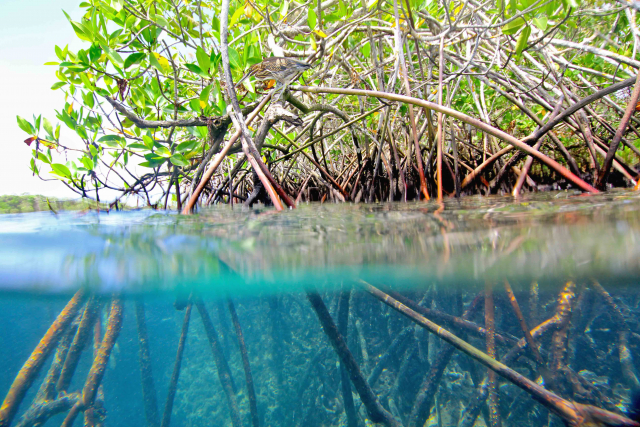16/04/2024 | A new publication from the Mangrove Ecology working group on the topic of blue carbon examines the temporal course of carbon storage and stocks in reforested and natural mangrove forests. The work is an important contribution to the BMBF-funded project sea4soCiety (https://sea4soCiety.cdrmare.de/en/) and thus to the overall research mission CDRmare of the German Marine Research Alliance (DAM).
What was the initial question of the study?
Martin Zimmer: How much the (re-)establishment of mangrove forests (and other coastal vegetated ecosystems) contributes to climate change-mitigation through additionally sequestered and stored carbon depends on the dynamics of carbon storage and stocks over time. Thus, there is an urgent need to understand how storage rates and stocks change over time in (re-)established vs. natural mangrove forests.
What exactly did you investigate?
Martin Zimmer: We performed a meta-analysis of data on aboveground, belowground, sediment and total ecosystem stocks of organic carbon, and burial rates of organic carbon in reforested, afforested, and naturally regenerated mangroves from the pertinent literature.
What are the new findings?
Martin Zimmer: We detected global temporal patterns of the development of aboveground and belowground biomass, as well as total ecosystem stocks of organic carbon. No such temporal pattern was obvious for sediment stocks or burial rates of organic carbon. According to these global patterns, growing mangrove trees increase carbon storage up to a century, although the storage rates slow down after some years and get close to zero after some decades. Sediment burial rates of organic carbon were nearly identical in (re-)established and natural forests.
What conclusions can be drawn from this?
Martin Zimmer: The latter finding suggests that the (re-)establishment of mangrove forests, i.e., reforestation in previous mangrove areas or afforestation in newly emerging potential mangrove habitats, is a viable and predictable means of increasing long-term blue carbon sequestration.
The global temporal patterns suggest that predictive models can be constructed to improve forecasting of mangrove carbon sequestration, assisting in sustainable development of mangrove plantations and mitigating climate change through market-based approaches.
How can the results be used?
Martin Zimmer: Taking into account the huge regional variability in the capacity of coastal vegetated ecosystems to sequester and store carbon in their biomass and sediments, our findings help close some knowledge gaps and to predict future storage rates and growing stocks in (re-)established ecosystems more accurately on local and regional scales (while, thus far, mostly global averages have been used to estimate stocks and storage rates). These, in turn, are important for monitoring, reporting and verifying (re-)establishment measures of mangrove forests in the context of carbon-offsetting and potential carbon credits on the voluntary (or even compliance) market.
Why are the results relevant for society?
Martin Zimmer: After an initial (and still ongoing) hype about coastal vegetated ecosystems as "blue carbon ecosystems" that significantly contribute to carbon dioxide-removal from the atmosphere and its long-term storage, several uncertainties, including regional variation in their capacity to store carbon, have recently led to question their relevance as nature-based solutions for climate change-mitigation. Increasing the accuracy of our predictions of carbon dioxide-removal and carbon-storage rates and capacities for both natural and technical approaches to climate change-mitigation will assist scientists in advising policy-makers and phrasing recommendations for decision-making politicians worldwide.
This paper is an important contribution to the BMBF-funded project sea4soCiety (https://sea4soCiety.cdrmare.de/en/) and, thus, the entire research mission CDRmare of the German Marine Research Alliance (DAM).
Publication
Alongi DN, Zimmer M. 2024. Blue carbon biomass stocks but not sediment stocks or burial rates exhibit global patterns in re-established mangrove chronosequences: A meta-analysis. Marine Ecology Progress Series (https://doi.org/10.3354/meps14560)





